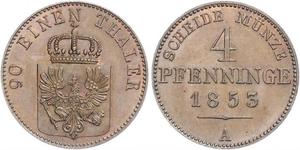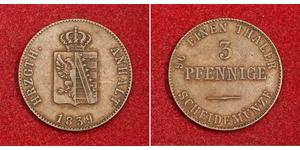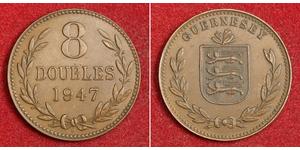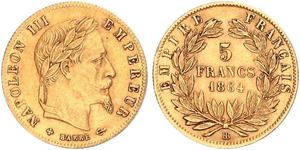(Vendida por $32.0)
1809, Principality of Waldeck-Pyrmont. Beautiful Copper Pfennig Coin. XF+
Condition: XF+ Mint Year: 1809 Reference: KM-24a. Denomination: Pfennig Material: Copper Diameter: 19mm Weight: 1.4gm
Obverse: Crowned coat-of-arms of Waldeck-Pyrmont. Legend: FÜRST. WALDECK. SCHEIDE MÜNZ
Reverse: Value (*I*) above denomination (PFENNIG) and date (1809). Mint official´s initials (F*W) below.
The County of Waldeck (later the Principality of Waldeck and Principality of Waldeck and Pyrmont) was a state of the Holy Roman Empire and its successors from the late 12th century until 1929. In 1349 the county gained Imperial immediacy and in 1712 was raised to the rank of Principality. After the dissolution of the Holy Roman Empire in 1806 it was a constituent state of its successors: the Confederation of the Rhine, the German Confederation, the North German Confederation, the German Empire and, until 1929, the Weimar Republic. It comprised territories in present-day Hesse and Lower Saxony, (Germany). Waldeck was a county within the Holy Roman Empire from about 1200. Its counts included Adolf II of Waldeck from 1270 to 1276. In 1655, its seat and the chief residence of its rulers shifted from the castle and small town of Waldeck, overlooking the Eder river and first mentioned in 1120, to Arolsen. In 1625, the small county of Pyrmont became part of the county through inheritance. In January 1712, the count of Waldeck and Pyrmont was elevated to prince by Charles VI, Holy Roman Emperor. For a brief period, 1805 to 1812, Pyrmont was a separate principality as a result of inheritance and partition after the death of the previous prince, but the two parts were united again in 1812. The independence of the principality was confirmed in 1815 by the Congress of Vienna, and Waldeck and Pyrmont became a member of the German Confederation. From 1868 onward, the principality was administered by Prussia, but retained its legislative sovereignty. Prussian administration served to reduce administrative costs for the small state and was based on a ten-year contract that was repeatedly renewed until Waldeck was formally absorbed into Prussia in 1929. In 1871, the principality became a constituent state of the new German Empire. In 1905, Waldeck and Pyrmont had an area of 1121 km2 and a population of 59,000. At the end of World War I, and during the German Revolution, resulting in the fall of all the German monarchies, the prince abdicated and Waldeck and Pyrmont became a free state within the Weimar Republic. The princely house of Waldeck and Pyrmont is closely related to the royal family of the Netherlands. The last ruling prince, Frederick, was the brother of Queen consort Emma of the Netherlands.
Friedrich Karl August, Prince of Waldeck and Pyrmont (German: Friedrich Karl August Fürst zu Waldeck und Pyrmont; 25 October 1743 – 24 September 1812) was Prince of Waldeck and Pyrmont from 1763 to 1812.
He was the second son of Karl August, Prince of Waldeck and Pyrmont and Christiane Henriette, Countess Palatine of Zweibrücken. He stayed on for one and a half years in Lausanne and made his Grand Tour through Italy and France.
Like his father and his brother Christian, he entered into foreign military services. In 1757 he was Imperial lieutenant colonel. In 1766 he became Major General and in 1772 lieutenant-general of the Dutch army. Working for the Netherlands already were three battalions from Waldeck, which had set up his father. Which Friedrich Karl August in 1767 added a fourth battalion.
At the death of his father in 1763. In 1775 he went on a journey to England. In Waldeck, he undertook several modernization efforts. He promote the construction of roads, agriculture and commerce. Like his parents and brothers, he was very fond of the sciences. He left a written history of the Seven Years' War, and some biographical sketches. He encouraged the publication of the memoirs of his father on the campaigns 1745-1747.
Friedrich Karl August rented Waldecker troops to Great Britain in 1775 to fight in the American Revolutionary War. A total of over 1200 Waldecker soldiers fought in America, over 720 men died during the war.[citation needed]
The principality was divided 1805, his brother George was given Pyrmont, and Friedrich Karl August stayed with Waldeck. In 1807, he joined with the Confederation of the Rhine and was given a seat in the College of Princes of the Federal Assembly
After his death in 1812, his brother George took over the government in Waldeck.

4 Pfennig Reino de Prusia (1701-1918) Cobre
grupo tiene 13 monedas / 13 precios
Add coin to this group

1/2 Kreuzer Imperio austríaco (1804-1867 ...
grupo tiene 2 monedas / 2 precios
Add coin to this group

3 Pfennig Reino de Prusia (1701-1918) Cobre
grupo tiene 21 monedas / 21 precios
Add coin to this group

2 Pfennig Reino de Prusia (1701-1918) Co ...
grupo tiene 5 monedas / 4 precios
Add coin to this group
5 Franc Segundo Imperio francés (1852-1870) Oro Napoleon III ...
grupo tiene 82 monedas / 81 precios
⇑












-300-150-4ckKbzbijD8AAAFLHDTk0Kj1.jpg)







